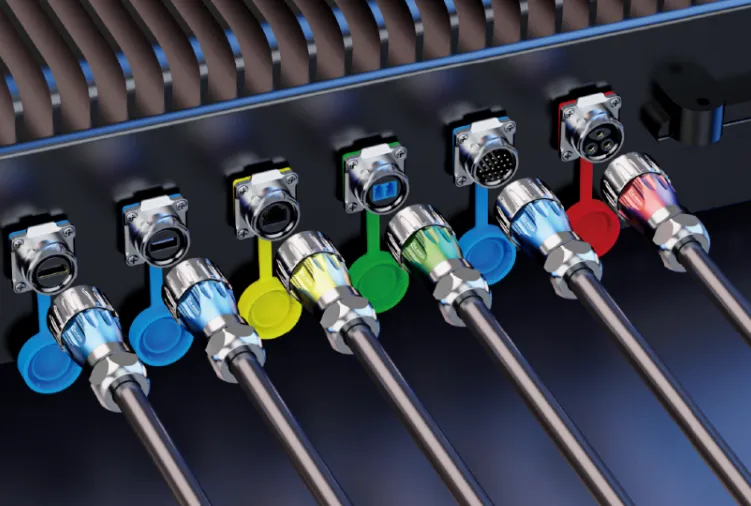Why is high and low temperature resistance indispensable for industrial grade connectors?
The application environment of ordinary connectors is usually relatively flat, and there is no depth requirement for high and low temperature resistance. In industrial equipment and automation systems, connectors are an important medium for electronic signal and power transmission, widely used in manufacturing, automotive, aerospace, energy, communication and other fields. With the continuous advancement of equipment and technology, the requirements for connectors in industrial environments are becoming increasingly stringent, especially in terms of performance stability in extreme high and low temperature environments.
The high and low temperature resistance has become a key technical indicator of industrial grade connectors, which not only relates to the reliability of equipment, but also affects the operational efficiency and safety of the entire system. Therefore, industrial grade connectors usually have excellent high and low temperature resistance, and their temperature range usually covers a wide range, making them fully compatible for use in outdoor, industrial, marine and other fields. This article will delve into why high and low temperature resistance is indispensable for industrial grade connectors.
What is the significance of high and low temperature resistance for industrial grade connectors?
| The impact of high temperature on connectors | The impact of low temperature on connectors | The necessity of high and low temperature resistance for industrial grade connectors | |
| environmental characteristics | High temperature environment (such as production equipment heat, exposure to sunlight, etc.) | Low temperature environment (such as cold regions, polar environments, etc.) | Industrial equipment often needs to operate under extreme temperature conditions and requires connectors with strong resistance to high and low temperatures to ensure stable operation. |
| main influences | Material aging and deformation | Material brittleness and fracture | Improve equipment reliability and achieve more stable performance |
| Decreased insulation performance | Decreased electrical performance | Extended service life | |
| Increased contact resistance | Poor contact caused by thermal expansion and contraction | Ensure operational safety | |
| Affects details | Plastic and rubber materials may soften, expand, or deform, affecting insertion and removal operations | Plastic and rubber materials become brittle and prone to breakage | Reduce malfunctions and maintenance costs caused by temperature fluctuations |
| The aging and brittleness of the insulation layer increase the risk of short circuit | Ice formation or decreased conductivity of conductive contacts | Long term operation to maintain stability | |
| Metal contact point expansion leads to poor contact | Poor contact caused by temperature difference changes | ||
| The impact of high temperature on materials | Plastic shell and sealing ring deformation | Plastic and rubber materials become brittle and prone to breakage | High and low temperatures may coexist, and high-performance materials that can withstand extreme temperatures need to be selected |
| Rubber loses elasticity and has poor sealing performance | The metal contact shrinks and the connection is unstable | ||
| Low temperature effects on materials | The connector housing and sealing components are prone to aging and oxidation at high temperatures | Low temperature causes rubber sealing materials to harden and plastics to become brittle | Choose materials that are resistant to high and low temperatures, such as polyimide (PI), polytetrafluoroethylene (PTFE), etc |
| Solution | Use high-temperature resistant materials such as high-temperature plastics or metal alloys | Using sealing materials with good low-temperature performance | Choose high-quality connectors with IP67 and IP68 certification to ensure long-term stable operation |
| Optimize contact design to avoid poor contact caused by expansion | Choose polymer materials that are not easily brittle at low temperatures | ||
| practical application | Equipment working in high-temperature environments such as industrial machinery, electrical facilities, automotive engines, etc | Equipment operating in extremely cold environments, such as aerospace, Arctic exploration, energy exploration, etc | Equipment fields with high requirements for safety and reliability, such as military, aerospace, etc |
| Maintenance cost | In high temperature environments, the failure rate of connectors is relatively high, increasing the frequency of maintenance | Poor contact, breakage, and other issues that may occur in low-temperature environments can also cause equipment shutdown and increase maintenance costs | Connectors with strong resistance to high and low temperatures can reduce maintenance and replacement frequency, saving long-term costs |
High and low temperature resistance is one of the important characteristics of industrial grade connectors, which determines whether the connector can operate stably for a long time in complex and harsh industrial environments. With the continuous deepening of industrialization, especially in high demand fields such as aerospace, energy, and transportation, the market demand for high and low temperature resistant connectors will further increase. Understanding its importance and selecting suitable products will provide a solid guarantee for the stability, operational efficiency, and safety of the enterprise's equipment.
To find products and services more accurately, please try entering keywords for search.
For more product and service content, please contact us and send an email to sales@dimud.com.
We sincerely look forward to connecting with you!


